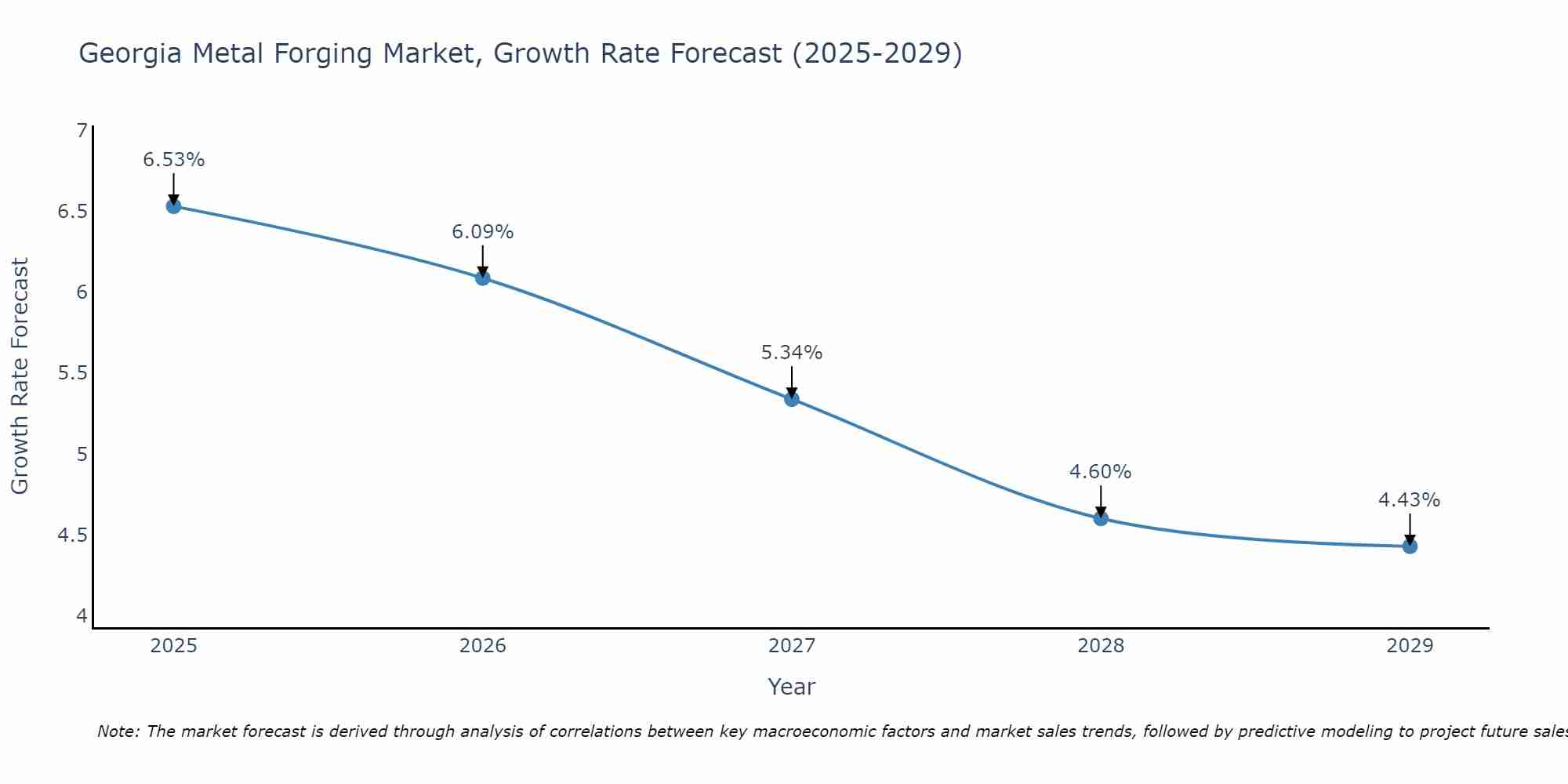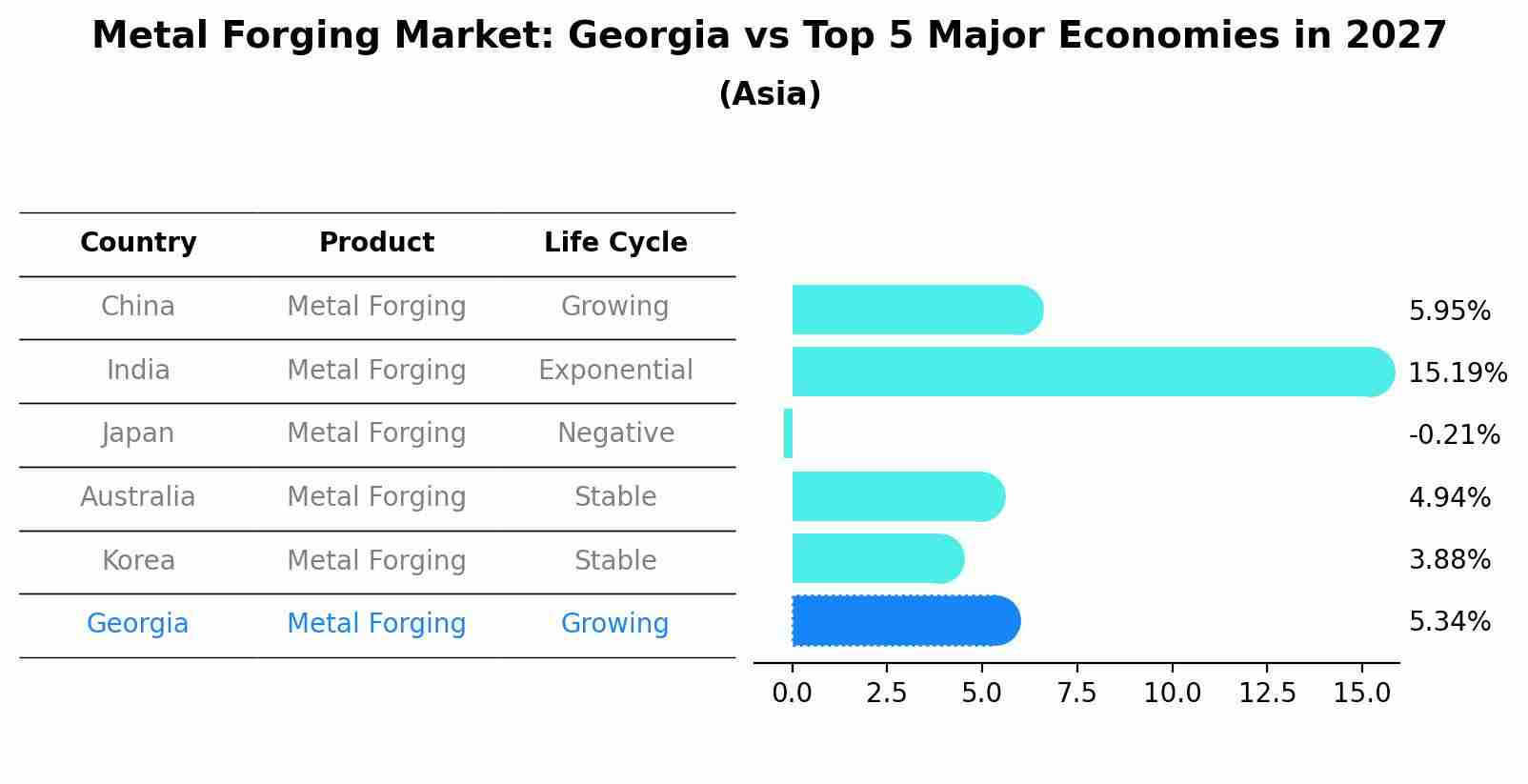Georgia Metal Forging Market (2025-2031) | Revenue, Forecast, Outlook, Share, Analysis, Trends, Industry, Value, Companies, Size & Growth
| Product Code: ETC039401 | Publication Date: Jan 2021 | Updated Date: Apr 2025 | Product Type: Report | |
| Publisher: 6Wresearch | Author: Ravi Bhandari | No. of Pages: 70 | No. of Figures: 35 | No. of Tables: 5 |
Georgia Metal Forging Market Size Growth Rate
The Georgia Metal Forging Market may undergo a gradual slowdown in growth rates between 2025 and 2029. Beginning strongly at 6.53% in 2025, growth softens to 4.43% in 2029.

Metal Forging Market: Georgia vs Top 5 Major Economies in 2027 (Asia)
By 2027, the Metal Forging market in Georgia is anticipated to reach a growth rate of 5.34%, as part of an increasingly competitive Asia region, where China remains at the forefront, supported by India, Japan, Australia and South Korea, driving innovations and market adoption across sectors.

Georgia Metal Forging Market Overview
Metal forging is a manufacturing process used to shape metal workpieces through compressive forces and controlled deformation, producing high-strength and durable components for various industries including automotive, aerospace, and oil and gas. In Georgia, the metal forging market is experiencing growth as manufacturers invest in forging technologies to meet the demand for forged products with complex geometries and superior mechanical properties. With Georgia strong industrial base and skilled workforce, the demand for metal forging services is increasing, driving market expansion and innovation in forging processes and materials.
Drivers of the market
The Georgia metal forging market is driven by the growth of automotive, aerospace, and machinery industries, which require high-performance and complex-shaped metal components for critical applications. Metal forging processes, including hot forging, cold forging, and impression die forging, produce parts with superior strength, durability, and dimensional accuracy. With the increasing demand for lightweight and fuel-efficient vehicles, as well as advanced machinery and equipment in Georgia, the demand for metal forgings is on the rise. Moreover, advancements in forging techniques, materials, and simulation tools further stimulate market growth by offering efficient and cost-effective solutions to manufacturers in Georgia.
Challenges of the market
In the Georgia Metal Forging Market, challenges include ensuring product quality, process efficiency, and market competitiveness. Forging companies must innovate to optimize forging processes, tooling designs, and material utilization to meet stringent tolerances and performance requirements for various industries such as automotive, aerospace, and oil & gas. Additionally, addressing concerns about forging defects, metallurgical properties, and environmental impact poses challenges. Moreover, market competition from alternative forming methods and offshore forging suppliers adds complexity to this sector, requiring continuous improvement and investment in technology to meet customer demands effectively.
Government Policy of the market
To support the growth of Georgia manufacturing sector and promote technological innovation, the government has implemented policies to encourage investment and innovation in metal forging. These policies may include tax incentives, workforce development programs, and infrastructure investments to enhance the competitiveness of Georgia metal forging industry and attract new businesses to the state.
Key Highlights of the Report:
- Georgia Metal Forging Market Outlook
- Market Size of Georgia Metal Forging Market, 2024
- Forecast of Georgia Metal Forging Market, 2031
- Historical Data and Forecast of Georgia Metal Forging Revenues & Volume for the Period 2021-2031
- Georgia Metal Forging Market Trend Evolution
- Georgia Metal Forging Market Drivers and Challenges
- Georgia Metal Forging Price Trends
- Georgia Metal Forging Porter's Five Forces
- Georgia Metal Forging Industry Life Cycle
- Historical Data and Forecast of Georgia Metal Forging Market Revenues & Volume By Raw Material for the Period 2021-2031
- Historical Data and Forecast of Georgia Metal Forging Market Revenues & Volume By Carbon Steel for the Period 2021-2031
- Historical Data and Forecast of Georgia Metal Forging Market Revenues & Volume By Alloy steel for the Period 2021-2031
- Historical Data and Forecast of Georgia Metal Forging Market Revenues & Volume By Aluminum for the Period 2021-2031
- Historical Data and Forecast of Georgia Metal Forging Market Revenues & Volume By Magnesium for the Period 2021-2031
- Historical Data and Forecast of Georgia Metal Forging Market Revenues & Volume By Stainless Steel for the Period 2021-2031
- Historical Data and Forecast of Georgia Metal Forging Market Revenues & Volume By Titanium for the Period 2021-2031
- Historical Data and Forecast of Georgia Metal Forging Market Revenues & Volume By Others for the Period 2021-2031
- Historical Data and Forecast of Georgia Metal Forging Market Revenues & Volume By Applications for the Period 2021-2031
- Historical Data and Forecast of Georgia Metal Forging Market Revenues & Volume By Automotive for the Period 2021-2031
- Historical Data and Forecast of Georgia Metal Forging Market Revenues & Volume By Aerospace for the Period 2021-2031
- Historical Data and Forecast of Georgia Metal Forging Market Revenues & Volume By Oil & Gas for the Period 2021-2031
- Historical Data and Forecast of Georgia Metal Forging Market Revenues & Volume By Construction for the Period 2021-2031
- Historical Data and Forecast of Georgia Metal Forging Market Revenues & Volume By Agriculture for the Period 2021-2031
- Historical Data and Forecast of Georgia Metal Forging Market Revenues & Volume By Others for the Period 2021-2031
- Georgia Metal Forging Import Export Trade Statistics
- Market Opportunity Assessment By Raw Material
- Market Opportunity Assessment By Applications
- Georgia Metal Forging Top Companies Market Share
- Georgia Metal Forging Competitive Benchmarking By Technical and Operational Parameters
- Georgia Metal Forging Company Profiles
- Georgia Metal Forging Key Strategic Recommendations
Frequently Asked Questions About the Market Study (FAQs):
1 Executive Summary |
2 Introduction |
2.1 Key Highlights of the Report |
2.2 Report Description |
2.3 Market Scope & Segmentation |
2.4 Research Methodology |
2.5 Assumptions |
3 Georgia Metal Forging Market Overview |
3.1 Georgia Country Macro Economic Indicators |
3.2 Georgia Metal Forging Market Revenues & Volume, 2021 & 2031F |
3.3 Georgia Metal Forging Market - Industry Life Cycle |
3.4 Georgia Metal Forging Market - Porter's Five Forces |
3.5 Georgia Metal Forging Market Revenues & Volume Share, By Raw Material, 2021 & 2031F |
3.6 Georgia Metal Forging Market Revenues & Volume Share, By Applications, 2021 & 2031F |
4 Georgia Metal Forging Market Dynamics |
4.1 Impact Analysis |
4.2 Market Drivers |
4.3 Market Restraints |
5 Georgia Metal Forging Market Trends |
6 Georgia Metal Forging Market, By Types |
6.1 Georgia Metal Forging Market, By Raw Material |
6.1.1 Overview and Analysis |
6.1.2 Georgia Metal Forging Market Revenues & Volume, By Raw Material, 2021-2031F |
6.1.3 Georgia Metal Forging Market Revenues & Volume, By Carbon Steel, 2021-2031F |
6.1.4 Georgia Metal Forging Market Revenues & Volume, By Alloy steel, 2021-2031F |
6.1.5 Georgia Metal Forging Market Revenues & Volume, By Aluminum, 2021-2031F |
6.1.6 Georgia Metal Forging Market Revenues & Volume, By Magnesium, 2021-2031F |
6.1.7 Georgia Metal Forging Market Revenues & Volume, By Stainless Steel, 2021-2031F |
6.1.8 Georgia Metal Forging Market Revenues & Volume, By Titanium, 2021-2031F |
6.2 Georgia Metal Forging Market, By Applications |
6.2.1 Overview and Analysis |
6.2.2 Georgia Metal Forging Market Revenues & Volume, By Automotive, 2021-2031F |
6.2.3 Georgia Metal Forging Market Revenues & Volume, By Aerospace, 2021-2031F |
6.2.4 Georgia Metal Forging Market Revenues & Volume, By Oil & Gas, 2021-2031F |
6.2.5 Georgia Metal Forging Market Revenues & Volume, By Construction, 2021-2031F |
6.2.6 Georgia Metal Forging Market Revenues & Volume, By Agriculture, 2021-2031F |
6.2.7 Georgia Metal Forging Market Revenues & Volume, By Others, 2021-2031F |
7 Georgia Metal Forging Market Import-Export Trade Statistics |
7.1 Georgia Metal Forging Market Export to Major Countries |
7.2 Georgia Metal Forging Market Imports from Major Countries |
8 Georgia Metal Forging Market Key Performance Indicators |
9 Georgia Metal Forging Market - Opportunity Assessment |
9.1 Georgia Metal Forging Market Opportunity Assessment, By Raw Material, 2021 & 2031F |
9.2 Georgia Metal Forging Market Opportunity Assessment, By Applications, 2021 & 2031F |
10 Georgia Metal Forging Market - Competitive Landscape |
10.1 Georgia Metal Forging Market Revenue Share, By Companies, 2024 |
10.2 Georgia Metal Forging Market Competitive Benchmarking, By Operating and Technical Parameters |
11 Company Profiles |
12 Recommendations |
13 Disclaimer |
- Single User License$ 1,995
- Department License$ 2,400
- Site License$ 3,120
- Global License$ 3,795
Search
Thought Leadership and Analyst Meet
Our Clients
Related Reports
- Germany Breakfast Food Market (2026-2032) | Industry, Share, Growth, Size, Companies, Value, Analysis, Revenue, Trends, Forecast & Outlook
- Australia Briquette Market (2025-2031) | Growth, Size, Revenue, Forecast, Analysis, Trends, Value, Share, Industry & Companies
- Vietnam System Integrator Market (2025-2031) | Size, Companies, Analysis, Industry, Value, Forecast, Growth, Trends, Revenue & Share
- ASEAN and Thailand Brain Health Supplements Market (2025-2031) | Strategy, Consumer Insights, Analysis, Investment Trends, Opportunities, Growth, Size, Share, Industry, Revenue, Segments, Value, Segmentation, Supply, Forecast, Restraints, Outlook, Competition, Drivers, Trends, Demand, Pricing Analysis, Competitive, Strategic Insights, Companies, Challenges
- ASEAN Bearings Market (2025-2031) | Strategy, Consumer Insights, Analysis, Investment Trends, Opportunities, Growth, Size, Share, Industry, Revenue, Segments, Value, Segmentation, Supply, Forecast, Restraints, Outlook, Competition, Drivers, Trends, Demand, Pricing Analysis, Competitive, Strategic Insights, Companies, Challenges
- Europe Flooring Market (2025-2031) | Outlook, Share, Industry, Trends, Forecast, Companies, Revenue, Size, Analysis, Growth & Value
- Saudi Arabia Manlift Market (2025-2031) | Outlook, Size, Growth, Trends, Companies, Industry, Revenue, Value, Share, Forecast & Analysis
- Uganda Excavator, Crane, and Wheel Loaders Market (2025-2031) | Strategy, Consumer Insights, Analysis, Investment Trends, Opportunities, Growth, Size, Share, Industry, Revenue, Segments, Value, Segmentation, Supply, Forecast, Restraints, Outlook, Competition, Drivers, Trends, Demand, Pricing Analysis, Competitive, Strategic Insights, Companies, Challenges
- Rwanda Excavator, Crane, and Wheel Loaders Market (2025-2031) | Strategy, Consumer Insights, Analysis, Investment Trends, Opportunities, Growth, Size, Share, Industry, Revenue, Segments, Value, Segmentation, Supply, Forecast, Restraints, Outlook, Competition, Drivers, Trends, Demand, Pricing Analysis, Competitive, Strategic Insights, Companies, Challenges
- Kenya Excavator, Crane, and Wheel Loaders Market (2025-2031) | Strategy, Consumer Insights, Analysis, Investment Trends, Opportunities, Growth, Size, Share, Industry, Revenue, Segments, Value, Segmentation, Supply, Forecast, Restraints, Outlook, Competition, Drivers, Trends, Demand, Pricing Analysis, Competitive, Strategic Insights, Companies, Challenges
Industry Events and Analyst Meet
Whitepaper
- Middle East & Africa Commercial Security Market Click here to view more.
- Middle East & Africa Fire Safety Systems & Equipment Market Click here to view more.
- GCC Drone Market Click here to view more.
- Middle East Lighting Fixture Market Click here to view more.
- GCC Physical & Perimeter Security Market Click here to view more.
6WResearch In News
- Doha a strategic location for EV manufacturing hub: IPA Qatar
- Demand for luxury TVs surging in the GCC, says Samsung
- Empowering Growth: The Thriving Journey of Bangladesh’s Cable Industry
- Demand for luxury TVs surging in the GCC, says Samsung
- Video call with a traditional healer? Once unthinkable, it’s now common in South Africa
- Intelligent Buildings To Smooth GCC’s Path To Net Zero


















